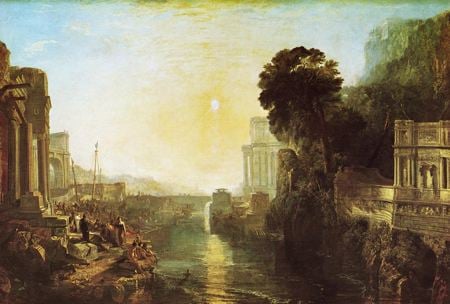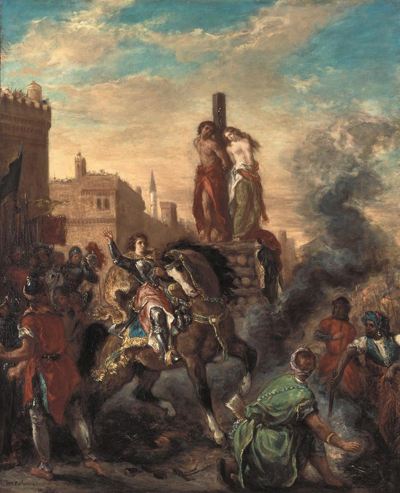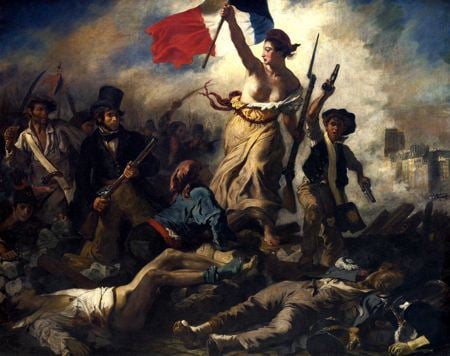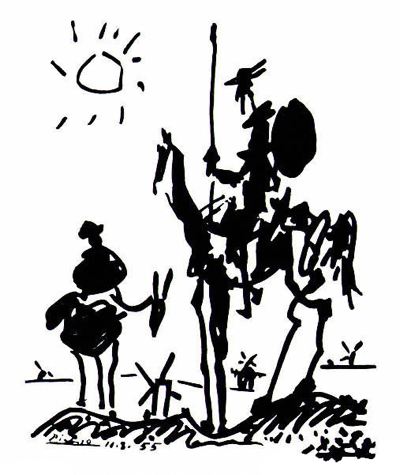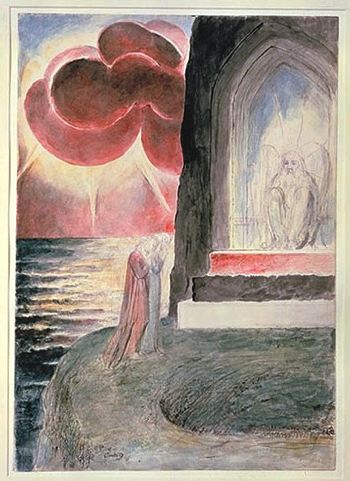“With Drooping Wings Ye Cupids Come”
Dido and Aeneas
Henry Purcell
St. Andrews Singers and English Chamber Orchestra
It’s Just a Story
Dido building Carthage aka The Rise of the Carthaginian Empire
J. M. W. Turner
http://de.wikipedia.org/wiki/Datei:Turner_Dido_Building_Carthage.jpg
Even before we begin to hear the music we can infer a bit about its subject. Even if we do not know the story of Dido and Aeneas from Virgil’s epic Aeneid the title of the aria, “With Drooping Wings Ye Cupids Come” suggests the subject of the song. Even those who do not know much about Greek or Roman mythology probably know enough about Cupid to know he is associated with love. That the wings of the Cupids are drooping suggests the news is not good news for the one who is in love. The music than affirms this observation and even though the words are difficult to make out, the music the words are set to tell us most of what we need to know about what they are saying. The music tells a story, as the painting tells a story. For those who have read the epic poem, just seeing the names of Dido and Aeneas tells a tragic story. But the real point is that not all stories are told with words, some are told with notes, rhythms, harmonies, and colors.
But stories also give us a common language, they help us talk to and understand one another. They can provide a frame or a context for our experiences; the “widow’s mite,” “the white whale,” “the melancholy Dane,” or “It is a truth universally acknowledged, that a single man in possession of a good fortune must be in want of a wife,” are all phrases and images that carry train loads of associations. When Ernest Hemingway titled one of his novels For Whom the Bell Tolls he was telling a story in five words that permeates the novel and colors the reader’s understanding of the events in theat novel. Of course, one must recognize the references or they are just nice sounding words. When Puccini plays the American National Anthem under a climactic scene in his opera Madame Butterfly he is using a musical phrase to tell another kind of story. If language and the possession of language are the vehicles in which our intellects travel, the materials that give shape and structure to our thoughts and ideas, then the well read, the “liberally” educated are fluent in a language and a vocabulary that adds richness, depth, and clarity to their thinking, even if the thoughts themselves are not that profound.
There was a review recently in the New York Times (“Her Calling”) of Marilyn Robinson’s book of essays, When I Was a Child I Read Books. The book is about the changes that have taken place in America over the past few generations that she finds troubling. But one of the early essays discusses myth and story and why they are, in her view important. She does not believe myth arose as a way to explain how things came to be. Though there may have been the Roman Fundamentalist that believed the stories were literally true, Robinson believes that the myths were seen by most as stories that communicated truths about what it means to be human and how humans ought to live and treat each other. Euripides used the story of the Fall of Troy as a way of commenting on the Peloponnesian Wars and Athenian behavior in that war.
Myth and religion are not science and are not to be understood as science. Whether, for example, the Book of Genesis is taken literally or figuratively isn’t the issue. The point of Genesis is not to explain how things came to be, so much, as to instruct us in how we ought to behave. There will always be some for whom the science of Genesis is important, but what is most important for us to understand from this book, whether we agree with it or not, has more to do with philosophy, ethics, and morality than it does with science. It could even be said that arguing the science of Genesis obfuscates the real message of the book. Whatever else an Athenian audience got out of Oedipus the King, they understood from the play that there were powers greater than ourselves to whom we are all answerable whether we are a shepherd or a king. And because Oedipus cannot escape these forces neither can anyone else and at the end of the day justice is done and order is restored. This is the message of the tragedy and why it was not a mere “theatrical” but a part of a religious ceremony. In this respect it might be said that the theater began in church.
Clorinda Rescues Olindo und Sophronia
Eugene Delacroix
http://en.wikipedia.org/wiki/File:Delacroix98.jpg
The paintings above and below are by Eugene Delacroix and each captures a different epic story of liberation. The first painting illustrates a scene from Tasso’s Liberation of Jerusalem. This is a story of the First Crusade and the “liberation” of Christianity’s (as well as Judaism’s and Islam’s) Holy City. Of course whether this was true liberation depends on which side is telling the story. Saladin would come around a bit later and liberate the city once again. What I found intriguing about Tasso’s story is that one of the more heroic knights from the story (which is also true of Ariosto’s Orlando Furioso and Spenser’s Faerie Queen) is a woman, in Tasso’s story, an Islamic woman. Women in the military was hardly a settled issue at the time and neither the Christian nor the Islamic community of the time looked favorably upon the “woman warrior.” When I read these stories I was surprised to find women in such prominent combat roles in the stories.
The painting below is of Liberty leading the people during the French Revolution, which brought another kind of liberation, again depending on which side one pledged allegiance. The young gentleman standing next to Liberty waving the pistols is said to have inspired Victor Hugo’s character Gavroche in the novel Les Miserables. However one feels about the liberation of Jerusalem by the Crusaders or the liberation of France by the forces of the revolution liberty is a powerful concept and stories of liberation often evoke powerful emotions, even if we have misgivings about the actual history.
Liberty Leading the People
Eugene Delacroix
http://en.wikipedia.org/wiki/File:Eugène_Delacroix_-_liberté_guidant_le_peuple.jpg
But how important or necessary are these stories. Do they shape character? Do the stories we read, as Marilyn Robinson and others assert, help to form the people we become or are they just another form of entertainment (which is not to suggest that if the stories shape character that they do not entertain as well). Tim Parks, in a recent article, “Do We Need Stories?,” doesn’t seem to think we need stories. He thinks assigning any great significance to them is a mistake, they give us pleasure, but they do not make us who we are, we are more significant and complex than stories. He ends his article, though, this way:
Personally, I fear I’m too enmired in narrative and self narrative to bail out now. I love an engaging novel, I love a complex novel; but I am quite sure I don’t need it. And my recently discovered ability, as discussed in this space a couple of weeks ago, to set down even some fine novels before reaching the end does give me a glimmer of hope that I may yet make a bid for freedom from the fiction that wonderfully enslaves us.
Though he does not believe stories are necessary he has not “liberated” himself from them. Some days I think I wake up agreeing with Parks, but usually come back to my senses (or non-senses as the case may be) before bedtime. Whether we have all felt the influence of an apple in a garden or not, does not alter the fact that we live in a world that falls short in a number of different aspects. And even if the story does not account for how this came to be, it offers a kind of hope that we can rise above what is wrong with the world. And even if the story has not shaped my character, in giving me hope it helps me move forward.
Don Quixote
Pablo Picasso
http://en.wikipedia.org/wiki/File:Donquixote.JPG
On the other side of the coin, Jennie Erdal wrote an article, “What’s the big idea?,” on the philosophical novel and its importance. At its heart, behind all the fun and nonsense, Don Quixote is a novel of ideas. Anyone who knows the story recognizes the errant knight in Picasso’ drawing and does not need a title to know who she or he is looking at. The windmills in the background evoke that part of the novel comes to mind for most, whether they have read the novel or not, when they hear the name of Don Quixote. It may be whether we have been shaped by stories or not, that we have all engaged in quixotic behavior of one kind or another. And even if Parks is right and none of us were shaped into the people we have become by this story, this story still defines, metaphorically of course, a bit of who we are. Erdal thinks that novels that wrestle with “big ideas” are important. She thinks the best philosophical novels are not those that discuss philosophy but those in which things with philosophical implications take place, they help us see things rather than try to explain things.
In Dostoevsky’s fiction, for example, characters wrestle with events with philosophical implications, but it is the wrestling matches that are the focus and it is through these bouts with moral and ethical ramifications that philosophy is put on trial. In this sense, perhaps, the reader is not shaped by what is read so much as led to consider what is true, what is just, what is moral and it is through this consideration, which does not require one to read a novel for it to take place, that the person is changed and character is shaped. The novel is less a sculptor giving shape to the rough rock that is our unformed personality and more a provocateur that incites us to consider ourselves in ways that might not otherwise have occurred to us and in ways that might be a bit dangerous. Perhaps there is a bit of a paradox in that we have to know ourselves before the stories and the contemplations they provoke can help us to become ourselves.
Building U. S. – China Relations by Banjo
Abigail Washburn
TED Talk
The film clip captures another kind of story; music builds more bridges than law. Songs are a form of story telling and even when the words are in a strange language, the sounds and rhythms and harmonies in the music communicate much of what the words would tell us if they could. Before watching this clip I never noticed the bluegrass in Chinese music. Whether these stories are essential, whether they teach us anything, or shape us in any way, they do open us up to one another, as the music did for the young child who lost her mother in an earthquake, and provide opportunities to know and understand one another. What is it in us that drives us to sing songs, tell stories, paint pictures; to make rocks, wood, and hedges look like people, animals, or kitchen tables? Part of it is entertainment, finding ways to fill the time, to amuse ourselves. But is this all there is; are they just stories? Sometimes I think stories give us a safe way of talking to one another. The stories that fill our time tell a lot about who we are, they reveal us to others, but we can sometimes fool ourselves into believing that because they are just stories that we are safe, that others will not put two and two together or solve the riddle.
The Order of Release
John Everett Millais
http://en.wikipedia.org/wiki/File:Millais_Order_of_Release.jpg
The painting tells another story of liberation. The guard looks quizzically at a piece of paper held up to him by a woman who gives the soldier a look of defiance and perhaps contempt. The man being released is wounded and tired. He is wearing a kilt while the soldier is wearing a British Army uniform. This suggests to me that perhaps the man being released was involved in the Jacobite Rebellion attempting to reclaim Scotland and the British throne for “Bonnie Prince Charlie.”
Being Scottish the history of the painting resonates with me, though those with little or no interest in Scottish history may not get nearly so much out of it. Part of what makes a story come alive is the way it resonates with our interests and passions. The most effective connections are emotional. There is a lot of emotion in this painting. There is the defiance of the woman, the sleepiness of the child, the excitement of the dog, and the fatigue and injuries of the Scottish clansman (I think that is a MacDonald tartan, but I can’t be sure). We do not need to know the history to be touched by the emotion in the painting. We have most of us been reunited with loved ones at one point or another. We have all at least wanted to stand up to authority especially when some we loved needed defending.
Tristan and Isolde with the Potion
John William Waterhouse
http://en.wikipedia.org/wiki/File:John_william_waterhouse_tristan_and_isolde_with_the_potion.jpg
I wonder at times if I make more of stories than they merit, if they are not a kind of intoxication potion that get us into trouble. I wonder at times if Tim Parks isn’t right, but my experience suggests otherwise. It agrees with Marilyn Robinson and Jennie Erdal. This to me is evidence. It is not scientific; it is not grounded in data, at least not the kind that is sifted in order to lend support to the conclusions of a formal study. It is subjective but it tries to take into account the experiences of others. I wonder about Mr. Parks and his fiction addiction. I wonder, is the need that it fills for him a real need or a psychological need. Is it like a well balanced meal that makes us healthy, or like smoking a cigarette that does us harm? In my experience stories help me understand people, ideas, and the heart’s core. It illuminates the mysterious.
I came home one summer from college for a visit. I wanted it to be a surprise, so I told my parents I was coming home on Wednesday when in fact I would be arriving in Los Angeles on a Monday. I have always liked to walk so I threw my duffle bag over my shoulder and walked from L. A. International Airport to my parents’ house in a little beachside community called Hollywood Riviera. I knocked on the door and my mother answered. Not being expected, she said we don’t want any and slammed the door in my face. I knocked again and this time my father answered, but before he could slam the door, I managed to introduce myself and he let me in. We often get from experience, what we expect. And we often see what we expect to see. Stories often shake up the expected or show us the expected in unexpected ways. I like to think my parents knew me and that the only reason they didn’t recognize was because I was not expected. Often stories work this way, we enter expecting to see something and then something happens and we see something familiar in new and unexpected ways.
The painting is of Dante and Virgil standing at the Gate of Purgatory. Purgatory is a transitional place. It is not a pleasant place but it is a place of hope. There is a way out. Sometimes there are moments in which we live that are transitional places. There is unpleasantness. There may be an unhappy ending that changes us and though the ending was unpleasant and painful the changes, once they take place transfigure that unhappy ending into a happy one. We are all seeking to climb the seven story mountain that brings us to that other, happier gate; but to get their we have to spend a bit of time in these transitional places. Stories help to pass the time and in the process often illuminate and hallow the time.
